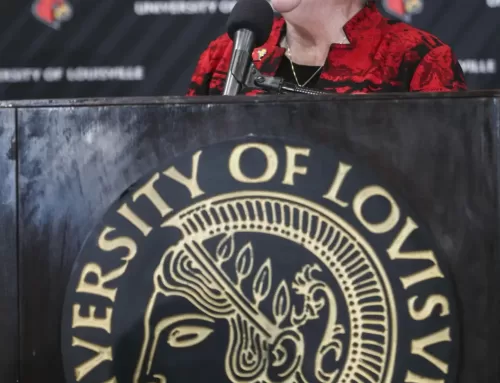By Olivia Krauth–
Close to ten months ago, a storm started brewing on U of L’s campus.
After a university-wide audit by Strothman and Company suggested U of L create a chief financial officer position, Harlan Sands was hired to be a change agent, melding finances and operations.
“Harlan is moving full speed ahead on a number of very important initiatives important to our future,” President James Ramsey said. “As I indicated in my State of the University Address, change is hard and Harlan is a change agent.”
In his time as U of L’s Chief Financial Officer and Chief Operational Officer, Sands has planned the $40 million SAC renovation and a large structural reorganization, affecting several departments and more than 600 staff members.
But the changes have come with a cost. Self described as “committed and focused,” the Navy veteran with degrees from University of Pennsylvania, George Washington University and George Mason University quickly developed a negative reputation for being “condescending and intimidating,” said one student.
When asked if he thinks people are afraid of him, he smiles and chuckles, quickly saying, “I don’t think so.”
“I think once I get to talk to folks one on one,” Sands said, “they can sense my commitment and see this is very thought-out and it is the right way to go.”
Sands’ first major moment on campus arguably got the most attention – the SAC renovations.
On Feb. 24, Sands joined other senior administrators at an SGA meeting to ask them to consider pushing back plans to renovate the SAC in hopes they would be able to renovate more of the center.
“I kind of took the pulse of the student body and the surrounding constituency groups and thought, ‘Boy, wouldn’t this be a great opportunity to do something more comprehensive,’” Sands said.
SGA’s original plan used more than $9 million in student fees to add meeting and convocation space, renovating about 10 percent of the total building. The plan had been in the works for four years and was set to begin last spring until SGA agreed to hold off for six weeks to hear what administration had planned.
SGA senators appeared frustrated and didn’t seem to trust Sands. Sands said he was working on funding the project without additional costs to students, but some thought that funding would be coming from athletics, which senators didn’t want.
While the Cardinal reported senators were blindsided in the tense meeting, those involved have nothing negative to say after months of additional work on the SAC proposal.
Service Vice President Kaylee Brandt said reports of Sands seeming annoyed in the first meeting were invalid, saying, “I have had a great experience working with Harlan Sands this past year in my position with SGA. He always makes sure that the students voices are heard and taken into great consideration.”
“Sands has a passion for students and everything he does is for the betterment of all current and future students,” graduate student Brandon McReynolds said. “His leadership will impact U of L for a long time to come. This type of passion and hard work brings forth a lot of emotion but as a student I know Mr. Sands does everything he can as a champion of student interest.”
The revised plan, approved last week by U of L’s Board of Trustees, has a $40 million price tag. Set to begin July 2016, the renovation and expansion includes new meeting spaces, new food service areas and a new bookstore. The outdoor ramp and the indoor escalator will also be removed. Only $9 million of the funding comes from student fees.
While the rest of the spring semester was relatively quiet for Sands, he was involved with Cards United Against Sweatshops’ venture to end U of L’s contract with JanSport.
While ultimately successful in their goals, some CUAS members did not have fond memories of working with Sands.
“In those last two meetings, Sands was very condescending,” CUAS member Nathan Groneck said. “He also threw a lot of jargon at us, contract terminology, economic stuff and was all around intimidating – cutting off students before they had finished speaking, and with the jargon and his statements, treating us as wholly unqualified to discuss the issue at hand – cutting the contract with an abusive, exploitative company.”
Groneck said “frustrations were running high after months of campaigning,” but the interactions with Sands left him with a mixed opinion of him, labeling his opinion “neutral skepticism.”
Sands’ second major change was announced in June. In a plan that would affect more than 600 employees, Sands was reorganizing the structure of the departments that report to him.
The Audit and Compliance, Finance, Business Affairs, Human Resources and IT units switched from reporting to the Provost to reporting to Sands when Sands started in January. Six months later, the new structure added to that.
The business affairs unit was split into operations and facilities management units. The finance unit was also split. The department of public safety began reporting directly to Sands. In an effort to increase efficiency, a new unit was added, to be called performance improvement and business analytics.
“You had a number of vice presidents who were reporting directly to the provost in the prior model,” Sands said. “When you take a look at these five units as a whole, independently led by vice presidents, we thought we needed to realign in a way to empower folks at that level, but the team now reports to a senior team led by me.”
A major change is having more specialists on staff.
“Instead of me training you to do 45 different functions, we have a small focused unit that is going to be centrally located to, for example, do all travel reimbursements,” Sands said. “You’re going to be the expert on all things travel, and you’re going to handle a much wider group of people.”
The change won’t eliminate jobs, but will redeploy people to where they are most needed.
“The goal here is to be more efficient, but the driving force is customer service and better operational support, and that’s what we all want,” Sands said.
The creation of an AVP of Performance Improvement and Business Analytics shows the importance of being efficient in the new model.
“I think it is so important to create a position that is completely focused on performance improvement and process improvement and customer service,” Sands said.
The reorganization created some backlash from making too many changes too quickly, a notion Sands disagrees with.
“I think we’ve been very deliberate about how we’ve gone about this,” Sands said. “We didn’t do this on my first day. We had a very robust discussion with senior leadership and folks that are part of the organization.”
According to management professor Lyle Sussman, organizational changes can take on different timelines depending on how important the problems are.
“If the problems are significant, changes are implemented immediately,” said Sussman. Sussman labeled cash flow, employee morale, product and service as examples of immediate problems. Depending on what they’re trying to solve, changes can be implemented within a week if needed.
“If it is immediate and drastic, it could be implemented in one day,” said Sussman, adding that operational changes tend to be much more immediate.
“If we are changing the company’s culture, if we are talking about how the employees feel about working someplace, that tends to be more long term,” said Sussman.
Sussman said it is often best to involve the people affected in the change. Sands said he visited more than 40 different U of L operations in his first 90 days, gathering input for the reorganization.
“The organization is the result of what our employees told me they wanted: customer service excellence, operational efficiency and a culture of accountability.”
“You’re not going to be successful if you don’t have a team that doesn’t involve a wide range of experiences,” Sands said, citing why input is important. “We have a great culture, why would I want to do anything to disrupt that? It has gotten us to where we are today. People here bleed red, and I love that. It is one of the reasons I was attracted to be here.”
The department of public safety now reports directly to Sands as part of the reorganization. Assistant Chief of Police Kenny Brown said the change highlights Sands’ “policies of direct access to decision makers, less bureaucratic layers and more input from his units.”
“He has been actively engaged in our efforts to promote the L-Trail and the new Card Guard safety app,” Brown said. “Sands has spent time riding and patrolling with the university police to see how police services are delivered to the campus community.”
“These areas are important in managing the day to day workload of the university police and very important during emergency situations where decisions must be made quickly,” Brown said.
“We see the changes as very positive because student safety and the university police go together in making all three of the university’s campuses safe and secure places to study, work, visit and enjoy.”
Two of Sands’ hires both followed him here from theUniversity of Alabama-Birmingham. Jeanell Hughes is the new associate vice president of human resources and Lee Smith is the newly-created assistant vice president for performance improvement and business analytics. Sands said the three had been contemporaries at the school, but he really just hires the best.
“It’s all about talented folks, and we will continue to hire talented folks,” Sands said.
According to Hughes, a national search for Smith’s job pulled in 32 applicants.
Smith accepted the offer and began in July. Hughes has been in her position since April, but will move to a position on Sands’ staff once a permanent human resources chief has been selected.
Sands said the next step in the reorganization is filling the final few senior assistant vice president spots, followed by implementing the changes.
According to Hughes, national searches are being conducted for the associate vice president for business services, associate vice president for Human resources and the associate vice provost for facilities management. Hughes said they plan on having the candidates selected by late fall.
After a shaky start, it seems like Sands has changed his tune, getting positive reactions from students and staff.
Groneck, the student member of CUAS, noted meetings with Sands were very different from last year.
“He has stressed his respect for the values and goals of our group, as well as communicated quickly and made himself available for timely meetings,” Groneck said. “He has been far more straightforward and we have not run into the same jargon and intimidation tactics as we did last year. The tone has been cordial and I am hopeful that the administration has learned some valuable lessons about respecting the student voice.”
Sands said he had been getting direct praise from some maintenance workers recently. “When you hear that from the guys on the ground, that are doing the day to day maintenance, it makes me think we’re doing the right thing,” Sands said.
“At the faculty senate meeting the other day, one of the faculty members raised their hand and said, “I just want to thank you. It’s been an exciting eight months. You’ve done a lot,’ and we’re going to do more.”




